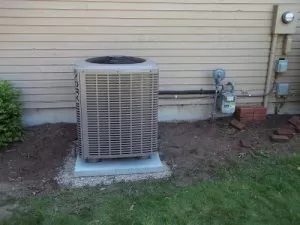As you cozy up in your home during the chilly seasons in Mill Creek, WA, you might notice certain areas feeling a bit cooler than others. These cool spots can be puzzling and uncomfortable, disrupting the warm, inviting ambiance of your home.
At BelRed, we understand the importance of a comfortably heated home, and we’re here to explore the potential causes of these pesky cool spots.
Possible Causes for Cool Spots in Your Home
Discovering cool spots in various areas of your home can be both puzzling and frustrating. These uneven temperatures not only affect your comfort but can also signal underlying issues with your home’s heating system or structure. In this section, we’ll delve into some common causes of these cool spots, providing insights into why they occur and how they can be addressed.
Inadequate Insulation
Inadequate insulation is a key factor in creating cool spots within a home. Insulation plays a vital role in preserving a stable indoor climate, serving as a protective barrier that minimizes heat escape during the winter and reduces heat intrusion during the summer. Areas such as attics, walls, or crawl spaces are particularly prone to insulation issues. When these areas are poorly insulated, they lose heat rapidly, making the surrounding areas noticeably cooler, especially during winter. Conversely, during summer, the same poorly insulated areas can become excessively warm, leading to uncomfortable hot spots.
Regular inspections of your home’s insulation can help identify areas where it may be lacking or has deteriorated over time. Upgrading insulation in these areas is often a straightforward yet effective solution. This could involve adding more insulation material, such as fiberglass, cellulose, or spray foam, to enhance the thermal barrier. The benefits of properly upgrading your insulation extend beyond just eliminating cool spots; it also improves your home’s overall energy efficiency, leading to reduced heating and cooling costs, and can enhance soundproofing, adding to the comfort and value of your home.
Damaged Ductwork
Damaged or leaky ductwork is another common cause of cool spots in homes with forced-air heating systems. The ductwork system plays a key role in circulating warm air throughout the entire home. If there are leaks, holes, or poor connections in the ductwork, it can lead to significant heat loss. This heat loss is most noticeable in the form of cooler temperatures in certain rooms or areas of the house, as the heated air escapes from the ducts before reaching these areas.
Detecting issues in ductwork can sometimes be challenging, as ducts are often hidden away in walls, floors, or ceilings. However, some signs can indicate ductwork problems, such as uneven heating in different rooms, higher than usual energy bills, or noises from the heating system. Professional inspections can accurately identify and diagnose these issues. Repairs might involve sealing leaks with duct sealant, insulating ducts in unheated spaces, or in some cases, completely restructuring parts of the ductwork for better efficiency.
Maintaining your ductwork through regular inspections and repairs is crucial for the health and efficiency of your heating system. In some instances, especially in older homes, it might be more effective to upgrade to a ductless heating system, which can provide targeted heating and eliminate the need for extensive ductwork.
Heater Size
The size of your heater plays a crucial role in its ability to evenly heat your home. A common misconception is that any size heater will suffice as long as it’s functioning. However, a heater that is too small for the square footage of your home will struggle to distribute heat evenly, leading to cool spots in various areas. This is particularly noticeable in larger rooms or extensions far from the heater. The heater works overtime to reach these areas, often failing to do so efficiently.
On the flip side, a heater that is too large for your home presents its own problems. It can lead to short cycling, where the heater turns off before it has had a chance to properly circulate warm air throughout the entire space. This situation not only leads to inconsistent heating across different areas but also escalates the wear and tear on the system, consequently shortening its overall operational life.
Addressing this issue usually involves consulting with heating professionals to assess the current heating needs of your home. They are capable of determining the right size for your heater by considering a range of factors, including the total square footage of your home, the height of your ceilings, and the quality of your insulation. Upgrading to a heater of the correct size can significantly improve the distribution of heat, eliminating cool spots and enhancing overall energy efficiency.
Blocked or Closed Air Vents
Blocked or closed air vents are one of the simplest yet often overlooked causes of cool spots in a home. Vents that are obstructed by furniture, curtains, or even rugs can significantly restrict airflow, preventing heated air from reaching parts of a room or even entire rooms. Additionally, homeowners sometimes close vents in unused rooms in an attempt to redirect heat elsewhere, but this can disrupt the overall balance of the heating system, leading to uneven distribution of heat.
Making sure all vents are clear and free from blockages is an uncomplicated but efficient measure in tackling the issue of cool spots in your home. It allows for the proper circulation of warm air, ensuring that it reaches all areas of your home. Regularly checking and cleaning vents can also improve airflow and heating efficiency. In some cases, if certain rooms remain cool despite open and unobstructed vents, it may indicate a need for additional vents or adjustments to the ductwork to improve air distribution.
Aging Heating Systems
As heating systems age, their efficiency and effectiveness can diminish, a common cause of cool spots in homes. Over time, components of a heating system can wear out, and the system may not heat as evenly or effectively as it once did. This decline in performance often results in certain areas of the home not receiving adequate heat, creating noticeable temperature differences. Older systems may also struggle to maintain consistent heat output due to issues like burner problems, diminished airflow, or compromised heat exchangers.
Regular maintenance can mitigate some of these issues, but there comes a point where the most cost-effective solution is to upgrade to a newer, more efficient system. Modern heating systems not only provide more consistent heating and eliminate cool spots but also offer improved energy efficiency, which can significantly reduce heating costs over time.
When considering replacing an aging heating system, it’s important to consult with heating professionals who can recommend the most suitable options based on your home’s size, layout, and specific heating needs. This ensures that the new system not only addresses the issue of cool spots but also aligns with your home’s overall energy efficiency goals.
Thermostat Troubles
The thermostat is the control center of your home’s heating system, and its proper functioning is essential for even heat distribution. Thermostat troubles can range from simple issues like dead batteries or incorrect settings to more complex problems such as faulty sensors or poor placement. A thermostat located in an area that is not representative of the overall temperature of your home, such as near a draft, a window, or in direct sunlight, can misread the actual temperature. This can lead to the heating system turning off before the entire house has been adequately warmed, resulting in cool spots. Similarly, an older or malfunctioning thermostat may not accurately gauge the temperature, causing inconsistent heating.
Addressing thermostat issues can involve a range of solutions, from relocating the thermostat to a more central and representative location in the home, recalibrating or repairing it, to upgrading to a newer, more advanced model. Smart thermostats offer additional benefits, such as the ability to learn your heating preferences, remote control, and even individual room temperature adjustments, all of which can help in eliminating cool spots and improving overall heating efficiency.
Maintaining Warmth and Comfort the BelRed Way
In facing the challenges of cool spots in your home, whether due to inadequate insulation, inefficient heating systems, or other underlying issues, the path to a comfortable and evenly heated space is clear with the right expertise. BelRed in Mill Creek, WA, is prepared to provide their expert assistance, guaranteeing that your home stays cozy and inviting in every season.
BelRed offers an extensive array of heating services in Mill Creek, WA, catering to a variety of needs. Our skilled technicians are adept at diagnosing and resolving a variety of heating issues, from repairing damaged ductwork and upgrading insulation to installing advanced heating systems and smart thermostats. Our focus is not just on fixing immediate problems but on providing long-term, energy-efficient solutions tailored to the unique needs of your home.
We understand the importance of maintaining a comfortable living environment, and our team is committed to delivering solutions that enhance both the warmth and efficiency of your home. By choosing BelRed, you’re opting for quality service, professional expertise, and lasting comfort.
Don’t let cool spots disrupt the comfort of your home. Contact BelRed today to schedule your consultation and discover the difference professional heating solutions can make. Reach out to us at (855) 345-6161, and let us help you achieve the perfect balance of warmth and comfort in your home.







